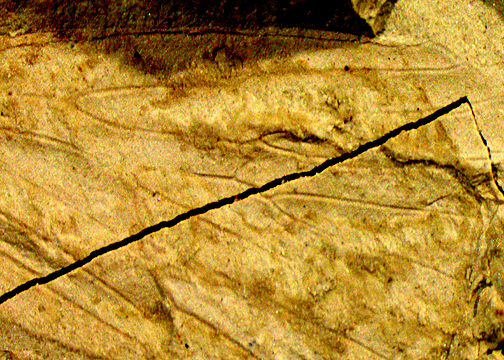Abstract
This article is devoted to the description of a new representative of the family Baissoferidae from the Khutel-Khara locality (Mongolia, East Gobi Aimag) located 75 km southwest of Mount Sain-Shand. The insect-bearing deposits of the Tsagan Tsab Formation, the Lower Tsagan Tsab Subformation in this locality are dated to the earliest Cretaceous, Berriasian-Valanginian. In total, about 3,300 fossil insect imprints of 14 orders were collected from the Khutel-Khara locality. It is important that the fauna of insects has both Jurassic and Cretaceous features. For example, many mayfly and stonefly nymphs that lived there (Sinitshenkova, 1987, 1989) were still typical Jurassic lacustrine forms, while among terrestrial insects, on the contrary, forms that occur mainly in the Lower Cretaceous of Transbaikalia (some rove beetles and scarabaeoids) prevailed (Ponomarenko, 2021). It is especially interesting that many forms are represented in Khutel-Khara, first appearing in the geological record, then widespread in the Lower Cretaceous. This primarily concerns hymenopteran insects (Rasnitsyn, 1990; Kopylov & Rasnitsyn, 2020).
References
- Butrim, M.J. & Royer, D.L. (2020) Leaf-economic strategies across the Eocene–Oligocene transition correlate with dry season precipitation and paleoelevation. American Journal of Botany, 107 (12), 1772–1785. https://doi.org/10.1002/ajb2.1580
- Carpenter, F.M. (1931) Insects from the Miocene (Latah) of Washington. 6. Trichoptera. Annals of the Entomological Society of America, 21 (2), 319–324. https://doi.org/10.1093/aesa/24.2.319
- Kopylov, D.S. & Rasnitsyn, A.P. (2020) Hymenoptera. Wasps and sawflies. In: Kopylov D.S. et al., The fossil Insects Lagerstätten Khasurty. Paleontological Journal, 54 (11), 1272–1280. https://doi.org/10.1134/S0031030120110027
- Kotov, A.A. & Korovchinsky, N.M. (2006) First record of fossil Mesozoic Ctenopoda (Crustacea, Cladocera). Zoological Journal of the Linnean Society, 146 (2), 269–274. https://doi.org/10.1111/j.1096-3642.2006.00204.x
- Lukashevich, E.D. & Przhiboro, A.A. (2012) Pupae of Mesozoic Jurochlus Kalugina, 1985 (Diptera: Chironomidae), with description of four new species. Zootaxa, 3478 (1), 434–452. https://doi.org/10.11646/zootaxa.3478.1.39
- Martynov, A.V. (1924) Rucheiniki [caddisflies] (Trichoptera). In: Bogdanov-Kat’kov, N.N. (Ed.), Prakticheskaya entomologiya [Practical entomology], Leningrad, 5, pp. 1–388. [In Russian]
- Mosely, M.E. & Kimmins, D.E. (1953) The Trichoptera (caddisflies) of Australia and New Zealand. Trustees of the British Museum (Natural History), London, 1–550. https://doi.org/10.5962/bhl.title.118696
- Ponomarenko, A.G. (2021) Obzor mestonakhozhdeniy iskopayemykh nasekomykh Mongolii. (An overview of the locations of fossil insects in Mongolia).
- http://www.palaeoentomolog.ru/collections/mong.loc.html
- Ponomarenko, A.G. & Prokin, A.A. (2014) 9.3. Insects in the ancient lakes of Mongolia. In: Dgebuadze, Yu.Yu. (Ed.), Limnology and palaeolimnology of Mongolia (Biological resources and natural conditions of Mongolia). Proceedings of the joint Russian-Mongolian Complex Biological Expedition RAS and MAS, 60, 285–309.
- Rasnitsyn, A.P. (1990) Hymenopterous insects and stratigraphy of the Cretaceous. In: Krassilov, V.A. (Ed.), Non-marine Cretaceous of the USSR. Materials of Conference of the Soviet working group of the Project 245 IGCP, Vladivostok, Oct. 1988. Vladivostok, pp. 15–18. [In Russian]
- Sinitshenkova, N.D. (1987) Istoricheskoe razvitie vesnyanok (Historical development of the stoneflies). Trudy Paleontologicheskogo Instituta Akademii Nauk SSSR, Nauka, Moscow, 221, 144 pp. [In Russian]
- Sinitshenkova, N.D. (1989) New Mesozoic mayflies (Ephemerida) from Mongolia. Paleontological Journal, 23 (3), 26–37.
- Sinitshenkova, N.D. & Zherikhin, V.V. (1996) Mesozoic lacustrine biota: extinction and persistence of communities. Paleontological Journal, 30 (6), 710–715.
- Sukacheva, I.D. (1968) Mesozoiskiye rucheyniki (Trichoptera) Zabaikalia (The Mesozoic caddisflies (Trichoptera) from Transbaikalia). Paleontological Zhurnal, 2, 59–75.
- Sukatsheva, I.D. (1982) Istoricheskoe razvitie otryada rucheinikov (Historical development of the caddisflies). Trudy Paleontologicheskogo Instituta Akademii, Nauk SSSR, Moscow, Nauka, 197, 112 pp. [In Russian]
- Sukatsheva, I.D. (1993) Oldest Polycentropodidae (Trichoptera) from Mongolia. Paleontological Journal, 27 (1A), 192–196.
- Sukatsheva, I.D. & Aristov, D.S. (2022) Caddisflies (Insecta: Trichoptera, Baissoferidae, Calamoceratidae, Philopotamidae) from the Lower Cretaceous Locality Baissa in Transbaikalia. Russia. Paleontological Journal, 1, 67–74. https://doi.org/10.1134/S0031030122010130
- Sukatsheva, I.D. & Vassilenko, D.V. (2013) New taxa of caddisflies (Insecta, Trichoptera) with reduced forewing venation from the Mesozoic of Asia. Paleontological Journal, 47 (1), 77–83. https://doi.org/10.1134/S0031030113010139
- Ulmer, G. (1903a) Hamburgische Elb-Untersuchung. V. Trichopteren. Mitteilungen aus dem Naturhistorischen Museum, Hamburg 20, 279–289.
- Ulmer, G. (1903b) Uber die Metamorphose der Trichopteren. Abhandlungen des Naturwissenschaftlichen Vereins in Hamburg 18, 1–154.


